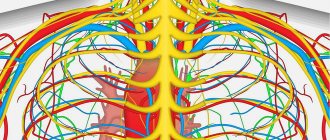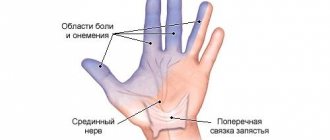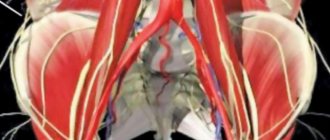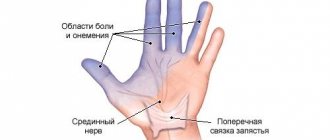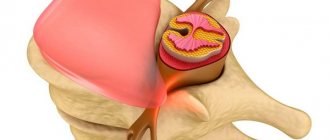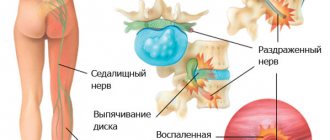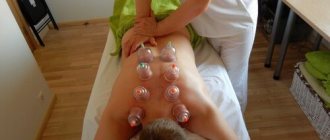The pudendal nerve (genital) is responsible for the innervation of organs and muscles located in the pelvis. It is divided into three branches, each of which provides movement of individual parts of the body: sphincter, perineum, genitals. Pinching or inflammation of the genital femoral nerve causes chronic pain in the pelvic area, which can be confused with cystitis, prostatitis and other diseases. Due to the anatomical features of the structure of the small pelvis, it is diagnosed 3 times more often in men.
Anatomical structure
There are noticeable differences in the anatomy of the pudendal nerve in men and women due to the structural features of the small pelvis. For the former, the concept of genital organs includes more structures than for the latter and it is more branched. In addition, in women these nerve fibers are located more compactly.
However, in both men and women, the pudendal nerve is a paired structure that arises from the spinal plexus. In people of both sexes, this nerve is divided into two large branches (femoral and inguinal), which are responsible for innervation:
- bladder sphincters;
- perineal tissue;
- levator ani muscle;
- sphincters of the rectum.
The inguinal branch in men and women performs different functions:
- In men, it is responsible for sensitivity and vegetative processes in the cavernous bodies of the penis and scrotum.
- In women, it performs the same functions in relation to the labia majora and minora, and the clitoris.
This structure, as well as the presence of vegetative fibers, ensures the automatic operation of various muscle groups responsible for urination and defecation, without the participation of consciousness.
Decompression of the pudendal nerve is a vital procedure that will not only eliminate discomfort, but also restore the functions of the pelvic organs.
SYNDROME OF "CAUSALGIA OF THE INGUINAL-GENITAL AREA"
This syndrome develops with damage to the iliohypogastric (n. iliohypogastricus), ilioinguinal (n. ilioinguinalis), and genitofemoral (n. genitofemoralis) nerves.
The function of all three of these nerves is to provide sensitivity to the skin in the groin area.
Neuropathy of each nerve can occur separately, but the similarity of their anatomy and clinical manifestations makes it possible to combine their damage into a single syndrome - the “causalgia of the inguinal-genital zone” syndrome.
The main complaint is burning pain in the groin area, spreading along the front surface of the thigh and along the abdominal wall. The pain intensifies when the muscles of the anterior abdominal wall are tense - when straining, when walking with long steps, when hyperextending the lumbar spine.
Sometimes a gentle gait is observed: a person moves in small steps with a lean forward, which reduces abdominal tension and, accordingly, pain.
An additional diagnostic test is to apply pressure to a point located slightly to the center of the anterior superior iliac spine. In this case, the pain characteristic of this syndrome is reproduced.
Factors provoking neuralgia
The pudendal nerve, like other structures of the pelvis, is exposed to various factors. The main causes of neuralgia of this type include the following:
- mechanical damage to the hip joint and adjacent tissues (including during operations);
- hypothermia of pelvic tissues;
- tumor processes;
- muscle spasm;
- hypertonicity of the piriformis muscle;
- complications of herperovirus infection;
- long and frequent horse rides.
Pathologies that cause dysfunction of the endocrine or cardiovascular systems can also provoke neuralgia. In addition, the possibility of damage to the pudendal nerve due to prolonged tuberculosis or collagenosis cannot be ruled out.
In addition, there are specific factors that provoke this type of neuralgia. Inflammation of the pudendal nerve in men occurs against the background of varicose veins of the spermatic cord. Such complications are rarely diagnosed with advanced prostate cancer. The causes of stretching of the pudendal nerve in women may be due to difficult and protracted labor or pathology of the large uterine ligament.
About the causes and symptoms of functional disorders
For the etiology of damage, the proximity to the ischium, which the nerve goes around entering the pelvic cavity, as well as the relatively shallow depth of the terminal branches under the surface of the skin and mucous membranes of the pelvic organs, are important. Therefore, dysfunction can occur as a result of:
- injuries to the perineal area;
Perineal trauma can lead to more serious consequences
Provoking factors may be:
- horse riding or cycling (frequently or professionally);
- prolonged labor;
- fracture of the pelvic bones (from a fall from a height, in a car or plane accident).
To understand that something is wrong with the genitofemoral nerve is made possible by dysfunctions of the organs located in the pelvis. These may be sensitivity disorders or autonomic disorders.
The first category includes both varying degrees of decrease in sensitivity (up to its complete loss) and an increase in pain to unbearable limits.
Deviations in autonomics are expressed by disturbances in the functioning of glands and other structures containing smooth muscle fibers, in particular, disorders of the mechanism of blood supply to the cavernous bodies of the penis or clitoris.
Trophic disorders of the skin of the perineum, scrotum and peri-anal area can also be a sign of disorders.
In addition to physical factors, the cause of pathology can also be general somatic diseases:
- tuberculosis;
- collagenoses;
- blood supply disorders due to endocrine disorders and vascular accidents or for any other reason.
Symptomatic manifestations
Sexual neurasthenia is characterized by extensive and nonspecific symptoms. The disorder is characterized by pain in the perineal area of varying degrees of intensity.
When the pudendal nerve is pinched in men, the symptoms of the pathological condition resemble manifestations of prostatitis or inflammation of the urethral canal, which complicates diagnosis.
Due to damage to these fibers, the innervation of the pelvic area is disrupted, which is characterized by:
- increased sensitivity of tissues in the pelvic area;
- constant feeling of discomfort in the anal area;
- uncontrolled urine output;
- feeling of a foreign body in the groin area;
- dysfunction of the genital organs.
With pudendal neuralgia in women, the general symptoms are supplemented by a sensation of itching and burning in the perineum, which intensifies in a sitting position. Since the femoro-inguinal branch runs to the anus and regulates the functions of the rectal sphincter, with a disorder of this type, stool disturbances (frequent constipation) are possible. Infringement of the pudendal nerve is also characterized by painful sensations that occur during intimacy. Moreover, this phenomenon in men signals damage to the prostate (prostatitis or prostate tumor).
Pudendal neuritis in rare cases causes a sensation of numbness in the muscles in the pelvis.
Pinching: reasons
Trouble may occur due to the piriformis muscle located in the pelvic cavity or due to compression between a pair of ligaments.
In addition, the pudendal nerve can be damaged after unforeseen situations, which include a car accident or a fall from a height. In such situations, a fracture of the pelvic bones may occur. Very often, the cause of chronic pain is damage to the nerve during childbirth or its involvement in the growth of a malignant tumor.
Diagnostic features
Due to the fact that neuropathy of the pudendal nerve causes pain in the pelvic area, ultrasound is indicated for diagnosis, which makes it possible to differentiate the pathology from other disorders of the genital organs. Using ultrasound, it is possible to determine the nature of blood circulation in the affected area. The absence of disturbances in this area indicates the presence of neuropathy. The doctor makes similar conclusions if, after applying cold to the perineum, the patient experiences temporary relief.
To confirm the preliminary diagnosis, Doppler sonography is prescribed.
To exclude prostatitis, cancer or prostate adenoma, the doctor performs direct palpation of the prostate gland in men through the rectum. In the case of severe deformation of local tissues and bones, such violations can be identified through radiography or external examination.
Also, in order to confirm suspicions of genital neurosis, in rare cases a novocaine blockade is performed. The drug is injected directly into the nerve plexus. If the patient experiences relief after the procedure, this indicates neuropathy.
NEUROPATHY OF THE OPTURATIVE NERVE (n. obturatorius)
The first signs of compression of the obturator nerve are usually pain that occurs in the groin area and along the inner surface of the thigh, in the hip joint.
Usually the pain intensifies with coughing, tension of the abdominal muscles, that is, with any conditions that increase intra-abdominal pressure. In addition, hip extension, abduction, and inward rotation contribute to increased pain.
There may be a feeling of numbness and “crawling” in the middle and lower part of the inner thigh. Later, a zone of reduced sensitivity (hypesthesia) appears in these same areas.
Motor disorders are manifested by weakness of the adductor muscles of the thigh: weakness when bringing the hips together, difficulty in fulfilling the request to put one leg on the other.
Traditional therapy for pudendal neuropathy
Due to the fact that inflammation of the pudendal nerve in women is caused by different causes and symptoms, treatment is largely determined by the characteristics of the provoking factor. In this case, patients are prescribed complex therapy. Muscle relaxants and anticonvulsants are used to treat pudendal neuropathy. These drugs improve the patient's general condition.
When the pudendal nerve is damaged, rectal suppositories with an active substance such as diazepam are used in treatment for men and women. Suppositories also provide pain relief. To restore the patient’s general condition, it is recommended to take vitamins C and group B.
For severe pain caused by a pinched pudendal nerve, painkillers are used, which are selected based on the intensity of the symptoms. In addition to anticonvulsants, sedatives that calm the central nervous system are often prescribed for these purposes. In extreme cases, when decompressing the pudendal nerve, droppers are prescribed (which will help is determined by the attending physician, taking into account the nature of the lesion).
Basically, a mixture of anesthetics and hormones is used for these purposes. This group includes drugs of the neuromultivitis class. Thanks to this blockade of the pudendal nerve, urination is restored and defecation is normalized.
If necessary, treatment tactics are adjusted. In case of compression of nerve fibers caused by a fracture of the pelvic bones or the growth of tumors, surgical intervention is performed. Such operations give a lasting effect, but require a long recovery.
If traditional treatment methods do not give a positive result, and the patient continues to be bothered by pain, they resort to ablation of the pudendal nerve.
To do this, pulsed currents are applied to the affected area. This effect relieves pain, normalizing the patient’s condition for more than a year.
Course of therapy
Treatment of neuropathy should consist of a set of measures aimed at eliminating inflammation, relieving pain and restoring nerve conduction. Typically it includes the following treatment methods:
- Elimination of pain with the help of anticonvulsants (Gebapentin);
- The use of physiotherapeutic procedures (phonopharesis, electropheresis, etc.);
- Blocking the nerve pathway with a solution of hormones and anesthetics;
- Use of muscle relaxants (Mydocalm);
- The use of vitamin complexes (Neuromultivit).
Neuromultivit vitamins and their analogues can be taken both as a component of a blockade solution and in the form of tablets. If the discomfort is severe, then suppositories for rectal or vaginal use based on Diazepam and special sets of exercises are used. The essence of physical therapy for neuropathy of the pudendal nerve is to compress and relax the muscles of the perineum.
If there is no point in continuing to treat medically damaged nerve tissue due to lack of results, then surgery will be required to decompress the compressed nerve. Such operations are extremely effective, but have a long recovery period.
With prolonged absence of treatment, the consequences of the pathology may develop. The disease can become chronic and some symptoms will be extremely difficult to eliminate. There have been cases of impotence and decreased libido, as well as increased involuntary urination and defecation.
Pudendal neuropathy is an unpleasant condition, but some people live with it for years. This is usually associated with vague symptoms and a chronic course. You can avoid such discomfort, but to do this you will have to undergo an examination and follow all the doctor’s recommendations.
Other treatments
Protracted sexual neurosis is treated through physiotherapeutic procedures. To eliminate signs of inflammation it is recommended:
- exposure to laser or dynamic currents;
- UHF;
- hot baths;
- wrap;
- paraffin applications;
- electro- and phonophoresis.
Quite often, when the pudendal nerve is pinched, treatment is supplemented with massage. During this procedure, blood flow in the problem area is accelerated, thereby relieving muscle tension and suppressing the inflammatory process. Massage is carried out during remission and only with the participation of a doctor. This is explained by the fact that such exposure during exacerbation of the inflammatory process worsens the general condition of the patient.
Special gymnastic exercises are effective. To prevent exacerbations when treating the pudendal nerve at home, it is recommended to bend and straighten the legs at the hip and knee joints daily while lying down, and perform rotational movements with the lower limbs. Over time, you can expand the list of exercises performed to include squats. The action of therapeutic exercises is aimed at strengthening the muscle corset.
During an exacerbation, it is recommended to treat the affected area with ointments that contain snake or bee venom (Myoton, Viprosal, Finalgon and others). Such drugs are prohibited from use during pregnancy and lactation.
As an addition, a tincture of fir cones, dandelions or pine needles (one glass per 0.5 liter of vodka) is often added to the general treatment regimen for the pudendal nerve. This product is used as a rub before bed. The tincture accelerates blood circulation, relieving inflammation and relieving pain.
A warm compress with beeswax melted in a water bath helps to achieve a temporary effect. This procedure is carried out before bedtime.
To relieve pain, an ointment is also used, obtained as follows: dried lilac buds are ground into powder and then mixed with pork fat in a ratio of 1:4. The resulting product is applied to the problem area twice a day.
Other procedures
Often, treatment of a pinched pudendal nerve requires the support of a good psychologist who performs correctional therapy and prescribes antidepressants. You may need to prescribe vaginal or rectal suppositories that contain diazepam. The patient may be prescribed special physical exercises, the meaning of which is to slowly compress and relax the muscles located in the perineum.
In situations where conservative treatment methods do not have a positive effect, decompressive surgeries are performed. They are performed in special centers for the treatment of chronic pelvic pain.
Preventive measures
For pudendal neuropathy, it is recommended to limit or completely abstain from cycling or horseback riding. If this cannot be done, then it is necessary to put on groin protection before each race.
In order to prevent neuropathy, it is necessary to promptly treat systemic diseases (especially the endocrine and cardiovascular systems) and avoid injuries to the pelvis.
Men and women should immediately consult a doctor if they experience persistent discomfort (pain) in the perineal area.
To prevent exacerbations of pudendal nerve neuritis, exercises to strengthen the pelvic muscle corset are mandatory. Therapeutic exercises are recommended to be performed daily.
